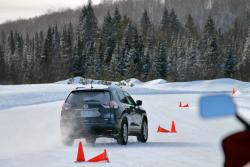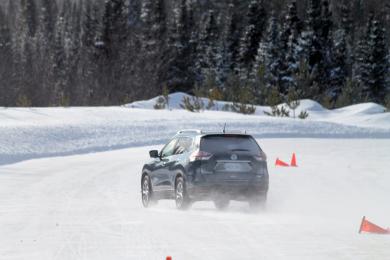Article and Photos by Justin Pritchard
As a mass suspended at each corner by a spring, a vehicle is subject to some fairly simple but often-overlooked laws of physics for every millisecond during which it’s in motion.
When at rest, or cruising at a constant speed in a straight line, the mass is stable. All is well, the vehicle is at ease, happy, and unlikely to do anything sketchy. Steer, brake, accelerate or hit a bump or dip in the road, and the mass bounces, rebounds, flexes and shifts about on its springs. These things can all cause the mass of a vehicle to become unsettled, with weight moving, shifting around and rebounding in the process.
When that sprung mass is badly unsettled, perhaps because of a big and sudden change like a sharp bump, sudden steering input or aggressive braking, the vehicle is in a less controllable state. It’s not as composed, planted or likely to go eagerly where it’s pointed without putting up a fuss.
  2014 Nissan Rogue. Click image to enlarge |
Add some speed and take away some traction, and the effects of a big disturbance to this mass on springs gets worse. Repeated exposure to these effects can make for a more stressful, tiring drive. And, in extreme cases, an unsettled chassis can result in a completely surprising loss of control, and an accident.
Numerous performance driving instructors comment to this effect. The usually imparted wisdom while covering the basics of weight transfer suggests that in the majority of accidents where drivers say the car ‘just spun out’ for no apparent reason, some extreme form of this unsettling of its chassis was at work. Maybe the driver went around a slippery downhill corner too quickly, panicked, hit the brakes, and therefore shifted weight off of the rear axle, making it lose traction and causing a skid. Or maybe they hit a big bump, mid-icy-corner, which flings the rear of the vehicle up off of its suspension into a moment of slide-inducing weightlessness. The gist? An unsettling of vehicle mass, in proper conditions, could cause the vehicle to try and roundhouse kick the guardrail on the other side of the road.
The highways leading out of Montreal towards Mont Tremblant are full of things that unsettle a vehicle’s chassis – especially in late January, when it’s 20 below and the roads aren’t fully cleared of snow and ice. Steep grades and long sweeping bends dotted with frost heaves and dips all pick away at the stability of a chassis moving over them.
One evening last week, unfamiliar with these highways and running massively late for a supper with colleagues, your writer experienced these conditions firsthand from behind the wheel of the second-generation Nissan Rogue. Usually, this sort of “in-a-rush / in-unfamiliar-territory / slippery / winding / bumpy / hilly /dark” combination is a recipe for driving stress. Or worse.
But to keep the new Rogue’s globally designed chassis settled and stable, the second-generation model employs three unique new systems that work away beneath its shorter-but-larger sheet metal body. Targeting an all-out assault on the compact crossover segment with hopes of raising the bar and attracting new shoppers, Rogue has advanced on all fronts – including those related to the interesting realm of electronic chassis control.
The first stability enhancing feature is called Active Trace Control, and it works with a simple concept: if slight braking is applied on one side of a vehicle, the vehicle will want to rotate in that direction. Imagine moving along in a canoe and dunking the broad side of your paddle into the water on one side. The canoe will rotate towards the side where the braking was applied. Same idea. With Active Trace Control, steering inputs are monitored, and slight braking is applied on both inner wheels as you steer around a corner. Result? Like the canoe, the braked wheels act like a sort of rudder, ‘planting’ Rogue to its driver’s selected arc, and making it keener to go where pointed, more smoothly, and with more confidence and stability. And you hardly notice it working, which is sort of the point.











